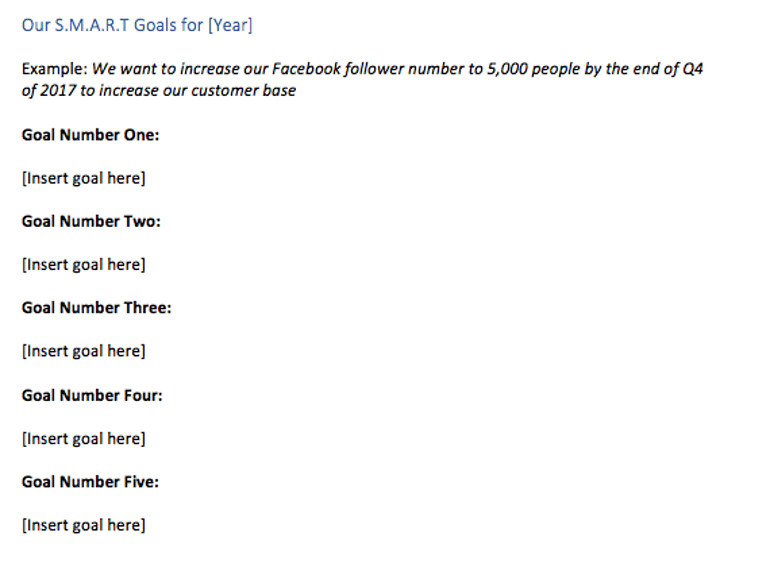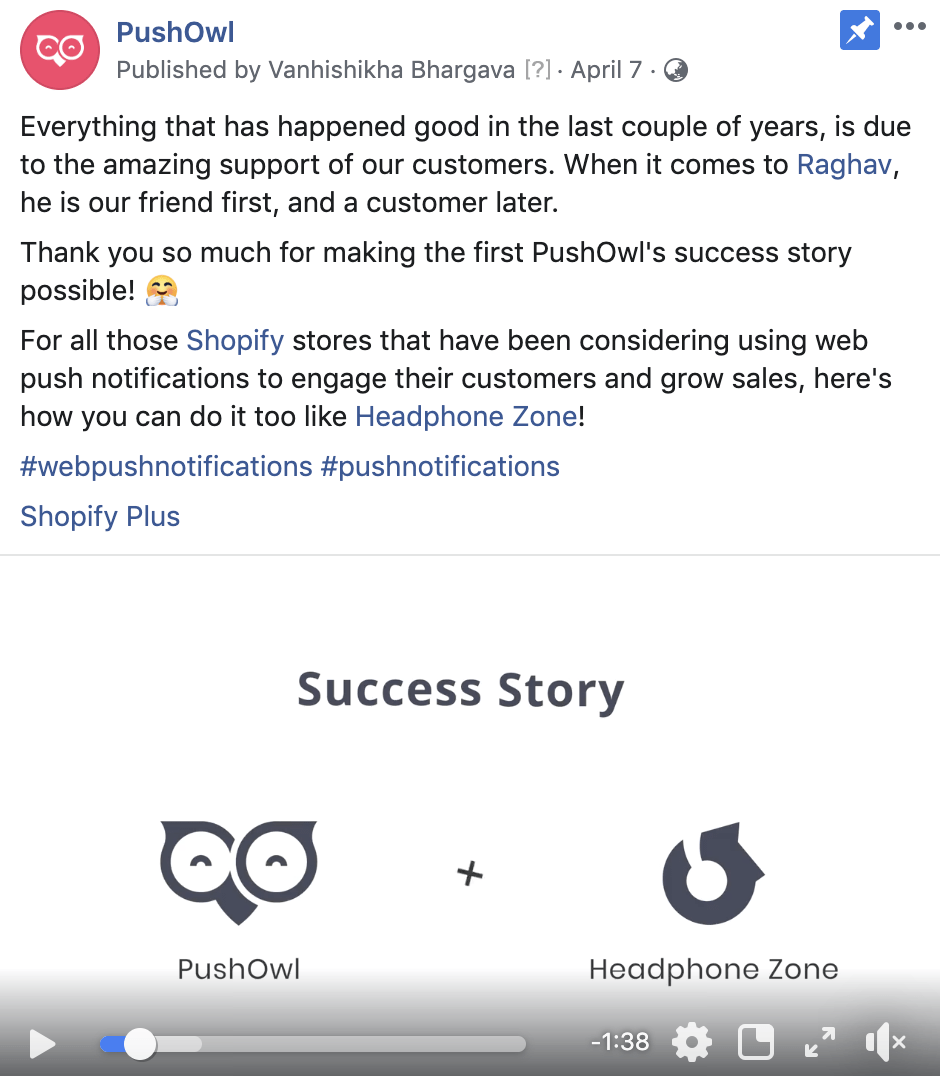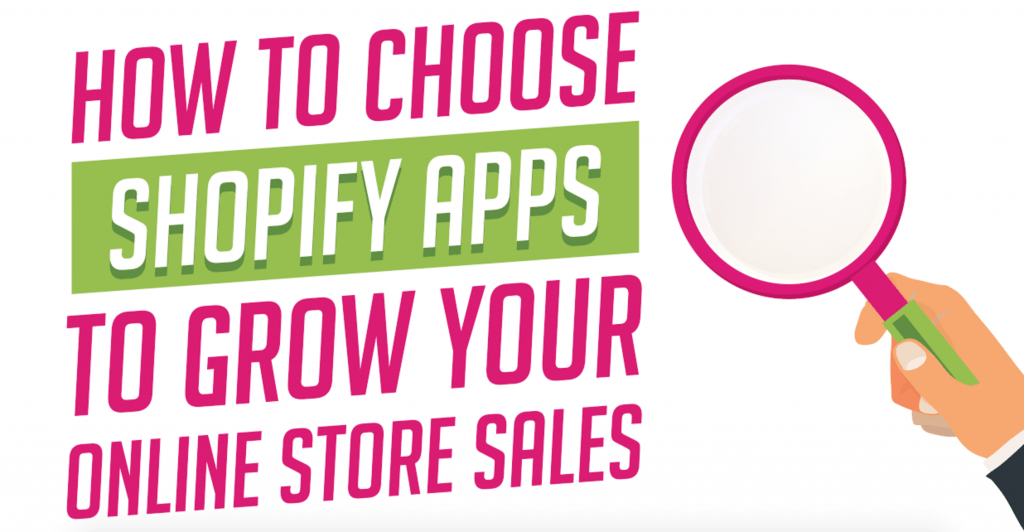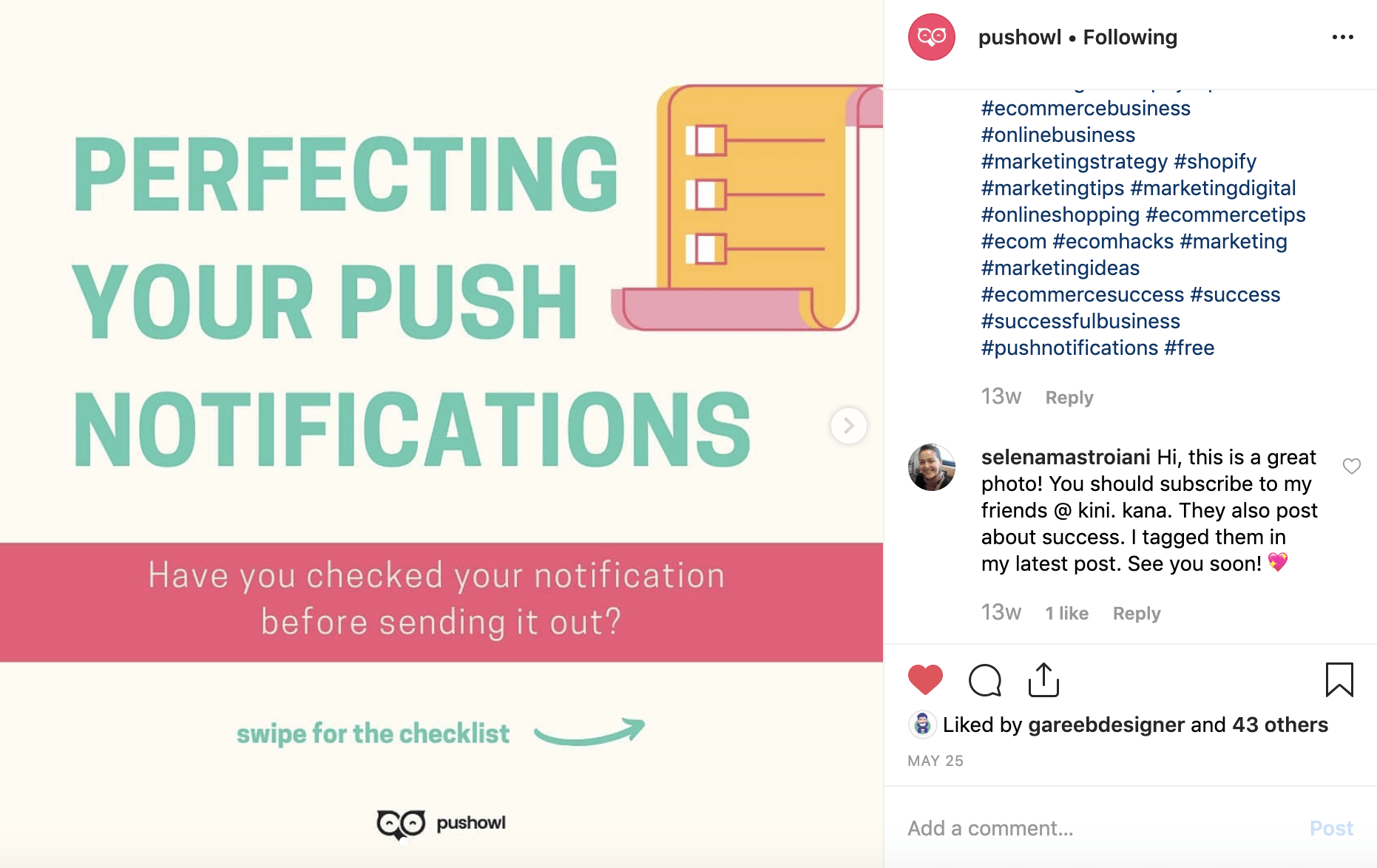Continuing on the series of using different tactics for Shopify app marketing, it’s time to cover social media. Despite the increasing amount of noise on social channels, it still remains one of the most promising channels when it comes to reaching out to a wider audience.
With 2.41 billion monthly active users and growing, you can’t possibly think your target audience is not active on the channel.
Especially when you have a Shopify app.
We all know how most eCommerce stores use channels like Facebook, Instagram, Twitter, Pinterest and others to grab the online shopper’s attention. No matter how big or small the Shopify store is, it surely has at least two social media profiles. Be it for showcasing their products or running ads, every brand is active on social media – and that’s exactly who your target audience is. Right?
But with so many apps and tools trying to reach out to the same stores to offer different solutions – some with a very high advertising budget and others who are relying on organic, how do you ensure your efforts yield installs?
Getting started with social media for Shopify app marketing
1. Set up clear goals for your Shopify app
The very first step to getting started with social media to drive effective results is to set up clear goals.
You need to define what you want to achieve from your social media strategy. For instance, are you looking at building brand awareness for your Shopify app? Are you looking at getting more likes and shares on the blog posts you’ve been writing? Or are you looking at getting more merchant leads that you can grow your sales funnel with?
It’s like clearly stating your expectations from a social media campaign.
CoSchedule shared a comprehensive post on how to set goals for social media marketing. It talks about following the S.M.A.R.T framework. For example, here’s a goal set for Facebook.

For instance, if you’re trying to increase the reach of your Shopify app on social media, a few metrics that you need to keep track of to check on goal-progress are:
- Organic reach
- Impressions
- Engagement
- Follower count
- Paid reach
Similarly, if the goal is to get more installs for your Shopify app, the metrics you should be measuring include:
- Clicks
- Conversions
- Leads
2. Understand your target audience is
Most Shopify merchants have their brands on Facebook and Instagram. But there’s a high chance that they’re using Pinterest and other platforms to market their products instead because they see more engagement there. Now if you’re trying to market to the latter on Facebook, you’re going to see no results!
That’s why, after setting your social media goals, you need to understand who your target audience is. And I’m not talking about simply categorizing your audience under ‘Shopify merchants’.
Drill down data to know who you would be talking to at a Shopify store. Is it the owner, the marketer, the person-in-charge of managing the online store, the social media marketer or their support?
This matters because your marketing messages will vary based on who you’re talking to.
For instance, you can’t possibly use the messaging, ‘grow Facebook likes’ for the owner of a Shopify store – that’s more suited for their social media marketer.
To get your audience data in place and understand who you’re targeting you should:
- Invest time in social media listening – It helps you find ongoing online conversations around your brand or the industry you’re in.
- Dig into competitor data – Look at Shopify apps that have a similar target audience as yours. Take note of how they’re engaging them and what merchants have to say about them, and how they’re putting forward their reviews.
- Shortlist keywords – Apart from brand-related keywords, search for terms that are more likely to get you traffic. Simply put, what merchants are using to search for solutions – pick them on the basis of intent and behavior to stay relevant.
- Identify hashtags – Take a look at what hashtags work the best in your industry and amongst the merchants you’re targeting. This will help you get your posts discovered faster.
- Identify the ‘who’ – Tap into online conversations on social media to understand the ‘who’ behind it. See if it is the owner of a Shopify store seeking recommendations or help or a marketer from the team.
3. Identify the right social media platforms
Based on the above data around who your target audience is, what kind of content they engage with the most, how they choose to interact with other Shopify apps, identify the social media platforms that will work for your Shopify app marketing the best.
There is no need to spread yourself too thin, trying to cover all channels in one go!
For instance, if you’re targeting the owners of a Shopify store and know they are the decision-makers, the right channel for you is LinkedIn.
On the other hand, if your Shopify app is addressing the goals of marketers, using Facebook and Instagram too in your social media strategy becomes a must.
And if your app’s conversions depend a lot on how well you educate the merchants with content, you’re going to need Twitter.
Here’s an interesting graphic shared by Social Media Today to help you pick the right social media platform to reach your target audience and grow your Shopify app.

Personally, I have seen two channels work the best for Shopify apps – Facebook and Instagram; especially when it comes to reaching target merchants and converting them into customers. LinkedIn helps in keeping up the image of a ‘company’ too of course!
My suggestion here is to start with Facebook and Instagram – you can create similar posts for the two channels, and compelling captions that explain what your Shopify app does.
The two are also the social platforms that the Shopify community is the most active on – be it in terms of merchants following content around Shopify or developers discussing solutions together.
When deciding on the social media platforms to include in your Shopify app marketing strategy, remember to also look for online groups and communities on them. Having just a page is not enough; you need to be where the conversations are happening.
You have no clue how far being just a little help to merchants and other Shopify apps can go in terms of customer acquisition!
Here are a few must-join Facebook groups for engaging with merchants and also discovering potential partnerships with other Shopify apps:
- Shopify E-commerce Strategy
- Shopify for Beginners
- Shopify Newbies
- Shopify Beginner Community
- Shopify Entrepreneurs
- Dropify – Hacking Shopify Dropshipping
- Shopify Unofficial
- Shopify Startups 6 Figure Mastermind
- Shopify Ecommerce Group
If you’d like an entire list of Facebook and LinkedIn groups to address an eCommerce audience, shoot me an email.
4. Create a brand style guide for consistency
Social media works best when you are consistent.
You don’t just need to post regularly on the platforms you choose, but also ensure that you’ve set clear expectations. Be it in terms of the look and feel of your posts, the kind of content you post or for the content theme that your Shopify app is an expert in talking about.
When you consistently put in the effort to create content that your target audience is looking for, you start reaching more people and building a following. A following that relies on your content for information and getting educated, and is more likely to convert on your campaigns, leading to more app installs.
Now while that might sound like an easy thing to do, 70% of marketers reported that they lack a consistent approach when it came to social media.
The reason? They never created a brand style guide and ran out of ideas.
Before you start with social media, it is important to create a guideline or a brand style guide. This document should consist of the following information:
- What is your Shopify app all about
- A marketing blurb for your app
- The challenges you’re solving for merchants
- The solutions you’re offering to the merchants
- Key statistics that merchants will relate to
- The topics you can cover and are associated with your Shopify app
- The tone of voice you want to maintain
- The posting frequency on each channel
- The set days for posting content on each channel
- The look and feel of posts – right from brand colors to what kind of stock images can be used
A lot of people would rather follow their instinct instead of putting together the above guideline. But what that eventually leads to are lack of ideas, inconsistent understanding of the brand’s goal amidst different members of the team and lack of consistency.
You end up being just like another Shopify app that makes a post today and then makes another a year after – when you don’t give the merchants enough value to follow you for, how do you expect them to install your Shopify app or even stick to it?
5. Set up a social media calendar
Another document that might seem too tedious to put together, is a social media calendar. Trust me when I say this, it is the only way you can ensure you remain consistent with your efforts on social media. It’s like planning ahead and keeping yourself accountable for making that plan happen!
Your social media calendar should clearly lay out the content you plan on posting, and on what dates. It should have a row for each social platform your Shopify app marketing strategy covers so that you can tweak your posts accordingly to suit the audience there.
Take, for instance, you wrote a 100 words caption for a post on Facebook and LinkedIn. But your strategy also includes Twitter.
Usually, a marketer would create an edited version of the caption they used on other platforms, on the fly. That often results in them either missing out on making the post or inconsistency in the message being delivered.
Now if the same marketer had a social media calendar planned out, their Twitter tweet would be ready too. All they need to do is copy, paste and tweet it out!
Here are a few things that a great social media calendar should include:
- Days and dates on which you plan to publish content
- The platforms you want to publish content on
- Clear categorization of the type of post you’re making – brand awareness, nurture/ educate, decision making
- Clear categorization of the theme you’re covering – very important if your Shopify app offers multiple solutions
- Captions for each of the social media posts to be made
- The call to action added to each of the posts – link to the website, link to Shopify app listing, link to a landing/ demo page, etc
- The image/ graphics/ videos you plan to use for each of the social media posts

Completed the above checklist? Now let’s talk about what kind of content really does well on social media for Shopify app marketing.
Content for Shopify app marketing on social media
1. Community and group conversations
The number one format of content that actually works in driving more installs for your Shopify app are community and group conversations. This is where you join the groups that your target merchants are a part of, with only one intention – helping them out in growing their stores with valuable information and genuine recommendations.
This might sometimes include answering questions that may not be directly linked to what your app does. The conversations help you gain the trust of merchants, build authority in the industry and use consumer psychology to drive installs for the app.
2. Case studies (text + videos)
Want to stand out from all the apps and tools marketing their solutions to Shopify merchants? Use a case study to grab their attention. Every merchant in the space looks up to another when it comes to benchmarking their growth. They’re always looking for answers to ‘how did brand x grow from 0 to x sales’, taking note of the apps they are making use of.
With case studies, you can highlight how a merchant has grown using your Shopify app. Be it in the form of a content piece, a dedicated crisp case study or a video that features the merchant sharing his review of the app. This content format is authentic in nature and that’s why it stands out on social media.
Here’s an example of a video case study on Headphone Zone using PushOwl:

And here’s Shopify using an Instagram post to give their merchants a platform to share their story – another authentic variant of case studies.

3. Videos
Be it case studies, how-to guides on your product or a blog turned more interactive, video content always does well. So much so that 51% of marketers across the world name video as the content format that drives in the highest ROI.
The reason being that videos make the message more consumable in nature. According to Statista, 85% of internet users prefer to watch video content on any of their devices. And Tabular Insights suggests that 64% of consumers make a purchase after watching branded social videos. After all, it helps them visualize what your Shopify app does much faster than having to read all the help docs or your app listing for that matter.
For example, WooHoo. The Shopify app enables stores to revamp their email popups with gamification. And while they write blogs to guide them through the use cases, their video explains the product faster:
4. Ebooks
When it comes to generating leads, ebooks are the best content format – both organic and paid on social media. The reason being that ebooks offer a comprehensive picture to the Shopify merchant – like right from A to Z, covering the smallest of concerns a merchant may have been trying to address a challenge or while using your Shopify app.
Take, for example, cart abandonment. It’s one of the biggest concerns for Shopify merchants. Now if your app helps the merchant recover abandoned carts or reduce cart abandonment, a complete guide on reducing Shopify cart abandonment’, could be a high-converting piece for your Shopify app marketing strategy.
Now if you’re thinking that ebooks take too long to create, you’re wrong. All you need to do is identify a topic that adds value to your target Shopify merchants and also gives you an opportunity to introduce your app in it. Then create a quick outline covering all the major aspects of what a merchant wants answers to – take a cue from online conversations.
Similarly, if you’ve written multiple blog posts around cart abandonment, you can bring them all together, making them crisper and actionable, and creating an ebook.
5. Infographics
Similar to video content, infographics make the consumption of the most overwhelming content easy. For example, if you’re sharing compelling statistics in a blog post, the text may become too much to consume – the same statistics in pie charts are a lot easy to take note of. Also, easier on the reader’s eyes!
If you’re wondering how can you share an entire infographic in a social media post, here’s the best part!
An infographic can be broken down into little snippets that can be shared on social media. You can then link the merchants to the complete infographic in the caption, leading them to the site and exploring more about your Shopify app.
For example, PlobalApps created an infographic on how to choose the right Shopify apps for a store. Since the infographic walks the merchant through different aspects of making this choice, the graphic can easily be broken into multiple posts for social media.

6. Blog posts
Content marketing brings businesses 69% more leads than any other traditional marketing tactic. It might be slow, but when done consistently, it is the one Shopify app marketing tactic that is sure to bring in long-term results.
Most Shopify apps simply share the links to their blogs with the title as the caption. I would suggest you put in a little more effort and create a little blurb for it instead. The marketing blurb should give the Shopify merchant a reason to click through the social media post and reach your site to know more about what it has to offer, giving you an opportunity to nudge them to install your Shopify app.
You can also get creative with your social media posts when sharing blogs. Repurpose the blogs into a series of images that summarise the contents of the post.
For example, PushOwl repurposed their blog on web push notification best practices into a carousel format of graphics to reach merchants on Instagram.

What content do you really need for Shopify app marketing?
Now there are a lot of content formats that you can use in your social media marketing strategy. But it all comes down to what content can you consistently create to promote your Shopify app. That’s where you need to take in the following into account:
- Who your target Shopify merchants are
- What kind of content do these merchants interact with
- What stage in the content funnel are these merchants at
- What marketing resources are available to you
- What content will you need to outsource
- What content is getting you the most engagement over time
You should also take into account the goal you’re trying to accomplish with social media marketing. Some of the most common ones being:
- Build awareness around your Shopify app
- Educate the merchants around a problem they face (and your solve)
- Offer an end to end solution to the above-mentioned problem (yours subtly included)
- Keep merchants engaged and boost your loyalty
- Show you’re an authority on the subject
- Reduce churn rate!
But the one thing you do need to follow is to always vary the content you create – be it in terms of the formats or the themes you’re covering to promote the various use cases of your Shopify app.
As a ground rule, don’t spread yourself too thin. Start with what you can tackle in-house or can easily outsource. Continually measure the performance of your content across different platforms to learn more about how Shopify merchants interact on them. And use that data to optimize your Shopify app marketing strategy for social media even further!
Not sure what content you should create for social media?
Let’s talk about your Shopify app and create a strategy together.





